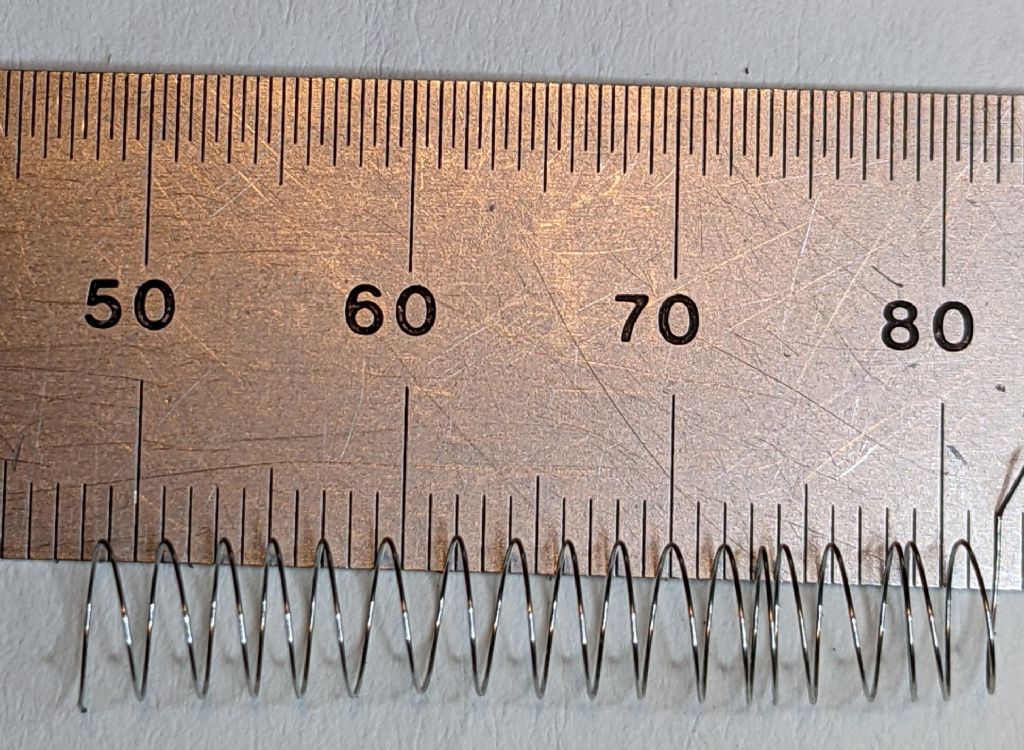Thanks to everyone who contributed to this significant though tiny piece of my clock, I had a successful afternoon testing what I considered to be the best combination of ME ideas provided by various Forum members.

Without your help, I think I would now be ankle deep in twisted guitar strings.

With reference to my latest photograph in my John Stevens Skeleton Clock album, and a section of Machinery’s Handbook about mandrel (arbor) sizes , here are some of the facts built into my first respectable attempt.
Method
The mandrel was machined down to size and cross drilled 1.0mm diameter next to the root radius. The free end of the guitar string was threaded through this hole, and the unsupported (cantilevered) mandrel given a couple of turns to `catch’ the wire.
The guitar string was then passed over a plastic (polypropylene) idle pulley of about 19.5mm diameter. I figured that this pulley should be quite large relative to the mandrel.
I positioned the pulley about 250mm from the lathe centre line so that the wire had more freedom to twist on its axis during the winding stage. I elected to leave the pulley with a plain diameter (rather than cut a groove), so that the wire had greater freedom to `roll’ sideways on its own diameter, and because the lathe did not captivate my interest in trying to match the wire pitch to the feed. In other words, I would close-coil the wire, and then `pull’ the spring length into position later. A weight was hung onto the end of the guitar string, and the lathe chuck turned backwards by hand.
IMPORTANT NOTE – TURN OFF THE POWER SUPPLY TO THE LATHE
.
With a sufficient number of turns on the mandrel to test the theories, I brought another piece of plastic hard up against the coils. The handle of a toothbrush gripped tightly in the tool post was very convenient for this purpose. I angled the contact face of the toothbrush handle so that the coil at the right hand end of the spring/mandrel would be the first to rotate. I intend to machine a proper face on the toothbrush handle to better suit the geometry.
At this point, the feed-end of the wire was cut, and the cross slide of the lathe very slowly and carefully withdrawn. It was necessary to trim a short tail off the wire so that the spring could readily unwind. The results can best be seen in the photograph.
Here are some details :-
The wire was a 0.2mm (0.008″) diameter guitar string, costing $2.00
The mild steel test mandrel measured 3.8mm (0.15″) diameter.
The idle pulley was 19.5mm diameter.
The tensioning weight measured 0.5kg
The resultant nominal spring OD was 7.6mm (0.30″)
The spring was slightly smaller than the drawing, so I plan to machine a mandrel with a diameter of 4.0mm
I am not too concerned about the spring pitch at this stage since I expect that the balance wheel will provide sufficient weight on the spring to pull it down. A side-effect from this would be that there will be less load on the balance-wheel thrust bearing.
Please refer to the previous threads on this subject, where you will find the valuable notes from other members.
Regards,
Sam
Edited By Sam Stones on 05/11/2010 08:06:28
John Haine.




 proved to be significant, even if it was only achieved with the plastic handle of a toothbrush.
proved to be significant, even if it was only achieved with the plastic handle of a toothbrush. 


